TAPAS.network | 24 April 2023 | Commentary | John Dales
Let’s find better ways to treat our urban trees

Three recent controversies surrounding the destruction of much-loved mature urban trees have highlighted conflicts between authorities wanting to press ahead with ‘improvement’ schemes that trees are in the way of, and the feelings and values of local citizens. has examined the circumstances in each case and finds a worrying neglect of both the intrinsic benefits brought to places by the trees concerned, and the attitudes and processes of those responsible for their removal.
I OFTHEN FIND THAT, once I’ve become keenly aware of a particular issue – perhaps for the first time; perhaps in a new way – then I seem suddenly to see it everywhere. The matter in question may have been drawn to my attention by someone else, or by something I’ve heard, read or watched, or it may have gradually seeped into my consciousness or suddenly struck me. In the context of what I’m writing about this time, the trigger was an invitation from the Editor of LTT magazine to reflect upon a couple of news items in the last-but-one issue of the magazine (LTT865). These concerned, respectively, the removal of thousands of street trees in the City of Sheffield during a period roughly 5-10 years ago, and the cutting down of just over a hundred trees in Plymouth city centre during a single night last month.
Since having been asked to think about this dimension of the urban environment, and thereby having had my tree-loss senses fully activated, I seem to have been seeing felled trees, and articles about felled trees, almost everywhere I turn.
Before coming on to the details of the ‘Sheffield Tree Scandal’, Plymouth’s ‘Tree Felling Fiasco’, and another sorry tale from London along similar lines, let me introduce a theme that I think is common both to these incidents, and to a seemingly unrelated matter that I have also been mulling over and propose to cover in my next TAPAS piece (no spoilers here, however). That common theme is composed of two threads: our general tolerance of actions that degrade the quality of our streets and urban realm; and the disconnect between those interventions and what the authorities in question say, or indeed what they do in related fields.
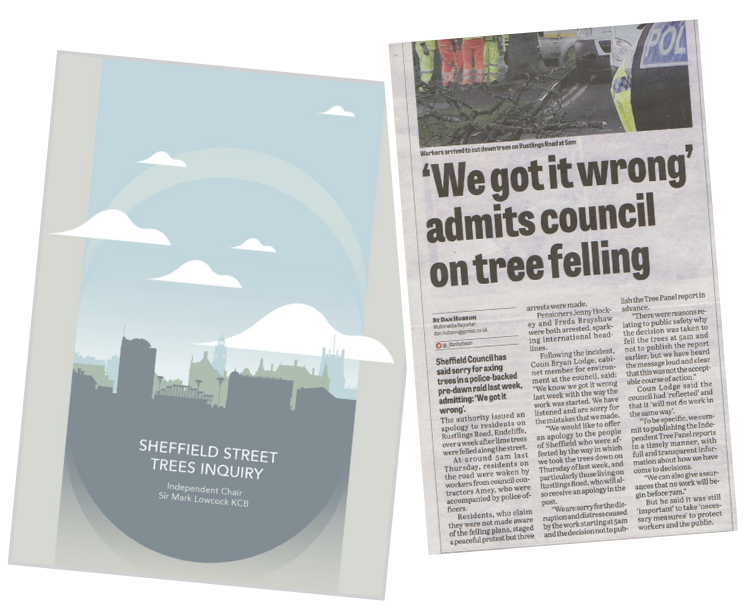
The Lowcock Report – 227 pages, almost none of which are or should be easy reading for the City Council
The basis for our acceptance of things we ought to find unacceptable seems to me to be that those things are usually hidden in plain sight – that they have become normalised, to the extent that we rarely think to question them, or perceive that we have the means to do so. It’s as though we fail to see the fate of the literal trees because we’re so familiar with the figurative wood.
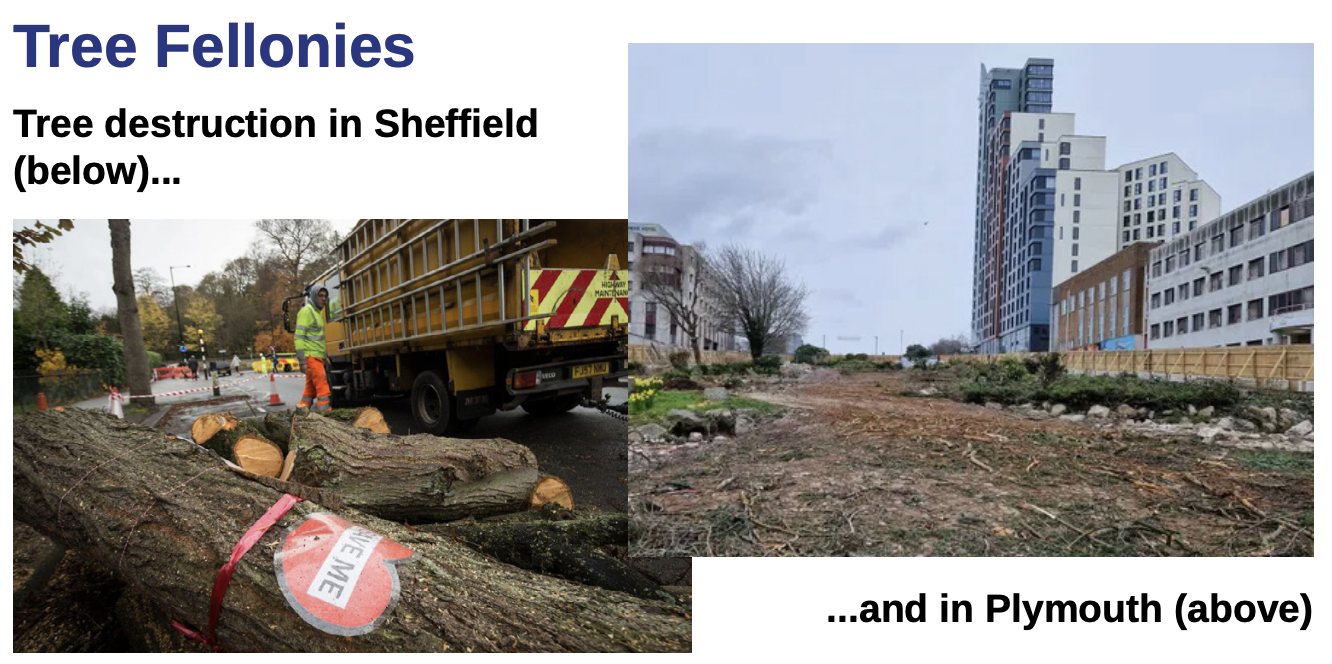
As for the words/deeds disconnect, what I’m referring to is how what Councils say – in terms of policy or strategy – is often not borne out in what they actually do, in the management of the streets for which they are responsible; especially at ‘the sharp end’ that is largely the preserve of maintenance and operational departments. It’s as if those charged with discharging the nitty gritty of a Council’s responsibilities often consider adopted policy to be just so many highfalutin words that don’t address the ‘practical realities’ on the ground. “That’s all very well for messaging a certain audience”, they seem to think, “but, down here in the real world, we’ve got an actual job to do, with increasingly challenged budgets. So, please don’t mind us if we pass on your nice-to-haves and get on with the have-to-dos”. Those higher up the ladder then seem to acquiesce, as if accepting that they’d rather over-reached themselves, policy-wise.
This is not necessarily to criticise; but it is to observe.
Be all that as it may, the forceful removal of street trees in Sheffield has stirred up a welcome – if sadly belated – discussion of such issues. This is as a result of the publication, last month, of the report of the Sheffield Street Trees Inquiry by Sir Mark Lowcock. (Sir Mark, by the way, has had a rather illustrious career as an economist, accountant, civil servant and diplomat; serving as the United Nations Under Secretary-General for Humanitarian Affairs and Emergency Relief between 2017 and 2021.) His inquiry was provoked by Sheffield City Council’s actions, and those of its contractor Amey, in pursuing the ‘Streets Ahead’ programme. This was designed to address what was widely agreed to be a highways maintenance crisis – with carriageways, footways, lighting and many street trees all being in poor condition. But it was in dealing with those pesky trees that things went badly wrong.
Full details of that sad story (lots and lots of them) can be found in the Lowcock report itself, which is downloadable. For our present purposes, a summary will however suffice, and this is as follows. Between 2012 and 2018, about 5,500 of Sheffield’s street trees were cut down, many of which were healthy and potentially had many years still to live. When opposition to this policy started to grow, the Council decided to resist it, taking an increasingly hard line until, in 2018, seeing a serious electoral backlash coming, it finally had to yield to the pressure. Indeed, in the local elections held in 2021, the Council itself and its leader was felled, and its governance model changed by a citizen-promoted referendum.
The subsequent inquiry found that the approach to street trees was indeed flawed. “The provision to remove and replace 17,500 trees, about half the total in the city, was arbitrary and misjudged,” the Lowcock report found. “It largely ignored the value of street trees. It failed to anticipate the views of significant numbers of people across Sheffield. The Council did not adequately consider whether its strategy of facing down the campaigners would work. Nor did it adequately consider whether the increasingly drastic action it was taking, and was seeking from both Amey and the police, was wise. It stretched the proportionate use of its authority beyond reasonable limits. The Council’s behaviour amounted to a serious and sustained failure of strategic leadership. Amey also bear part of the responsibility,” the report concluded.
The report notes that, in not foreseeing the likely opposition to the tree removal programme, the Council and Amey overlooked the obvious fact that people were likely to see a world of difference between a newly planted tree and a large mature one. It wasn’t that something didn’t need to be done about Sheffield’s street trees: it was that how the Council went about meeting the challenge was wrong.
The recent Plymouth street tree story is, to my way of reading it, almost a potted version of Sheffield’s. It’s one that began with good intent, but lost its way. Between 8pm on 14th March and 1am the next morning, 110 trees were felled on the city’s processional Armada Way, the literal centrepiece of Abercrombie and Watson’s 1943 Plan for the reconstruction of the city centre following the destruction wrought by bombing during World War Two. The iconic Armada Way became an integral part of Plymouth’s post-war character, and although various changes to the original layout have been implemented over time, including the in-filling of the 1970s-era subway under Royal Parade in 2004, the trees along the route flourished and grew in stature, as Abercrombie and Watson doubtless intended.
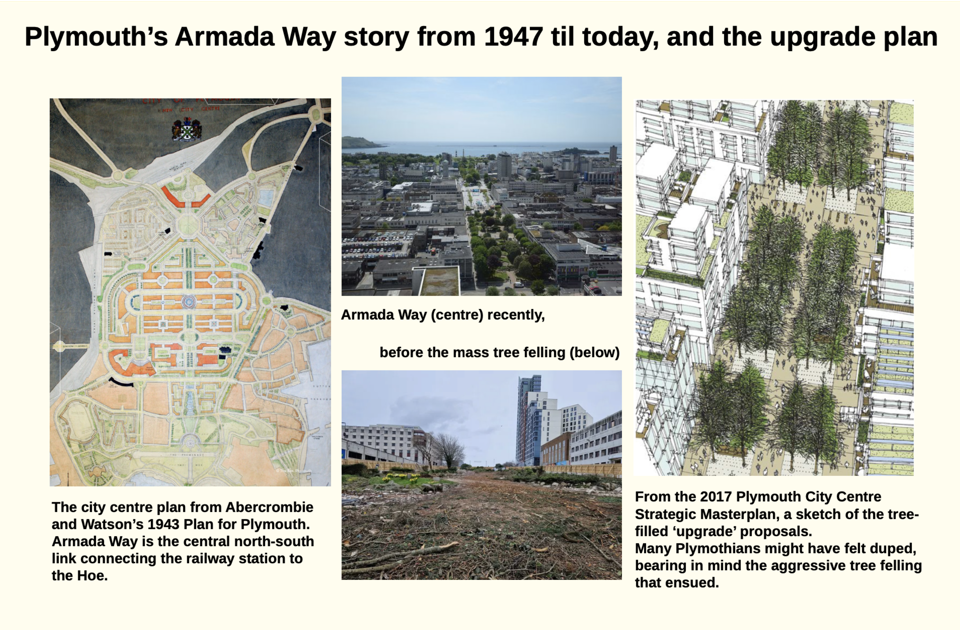
If I may, I’ll invoke an author’s prerogative at this point and take a slight detour, if not down a rabbit hole, at least into the subway. In 2020, the Plymouth Herald ran an article entitled “Journey down the magical world of Plymouth’s subways”. This described the aforementioned Royal Parade subway as “much loved” and suggested that “Plymothians may feel a pang of nostalgia when remembering the most iconic subway of our city, which is no more”. The piece also spoke most approvingly of subways, because they “allow pedestrians to walk safely across the road without having to come into contact with busy cars”, a rose-coloured view of resolving conflicts between people walking and motor vehicles that my regular readers will know I believe can be achieved in rather better ways.
I would strongly suspect the Plymouth Herald of being in the pay of ‘Big Underpass’, a literally shadowy subsidiary of ‘Big Oil’, were it not for the fact that the 2020 article actually goes on to be a pretty good read on the pros and cons of subways. Professor Alessandro Aurigi, Professor of Urban Design within the School of Art, Design and Architecture at University of Plymouth, is extensively quoted. I particularly like this summation: “The problem is, it’s a surrender. It’s like saying cars are the most important thing in the city, more important than pedestrians and people. So, we’ll drive people underground to make them safe.” You can read more, if you wish here.
By 2022, a new period of change to Armada Way was being proposed. This came as part of a comprehensive programme set out within the 2017 Plymouth City Centre Strategic Masterplan. Whatever its general merits, the specific fact that concerns us here is that the proposed works included significant loss of mature trees. When these details were made known, they provoked considerable opposition to the plans, including the founding of the group STRAW – Save the Trees of Armada Way.
Because of this opposition, work on the scheme was put on hold last November, so that the City Council could undertake what it called “meaningful community engagement” on the plans. This was a single-week exercise that took place early in February this year. It would not be unfair to say, given what subsequently transpired, that this effort at reaching out was badly bungled. According to the Herald, the Council had said, on March 10th, that it was finalising the consultation report. Yet, just four days later, and without that report being made public, the decision was taken to press ahead with the tree felling. It may be that the apparent urgency was occasioned by deadlines associated with some of the scheme funding, but that, on its own, is never (and should never be) sufficient justification for pursuing the things that the funds being spent on, if those things are not in themselves worthy.
Again according to the Herald, 68% of around 2,250 respondents to the ‘meaningful engagement’ did not support the £12.7m Armada Way upgrade plan, with only 16% (365) in support and a further 15% (330) conditionally supporting, subject to changes being made. Responses from within the city boundary (the Council’s voters) showed that an overwhelming majority of respondents opposed the scheme. Despite this, the Council was reported as claiming that, if it discounted the responses from people who said they were opposed to the scheme but didn’t say why, “then the scheme has significant support”. Quite a remarkable interpretation, it would seem.
In essence, the Council blamed STRAW for having skewed the balance of responses, and therefore chose to ignore the engagement outcomes, inadvertently deeming the process not-meaningful. It was evidently in far too much of a hurry to proceed, and did precisely what Sheffield had previously done: doubled down on Plan A, despite the opposition.
As had also happened in Sheffield, this resulted in actual on-street confrontation, although Plymouth had plainly anticipated it. The Herald reports that, shortly after an executive order had been signed to permit the tree felling to begin, fencing was erected and police with dogs, together with other security staff, patrolled the worksite while contractors used chainsaws and heavy machinery to chop the tree-obstructions down. The felling was stopped at about 1am when STRAW served a court injunction on the Council. However, by that time, about 110 of the 129 threatened trees had been removed: an average of over 20 trees an hour felled in just five hours. It’s as if the Council was taking a leaf out of Macbeth’s book: “If it were done when ‘tis done, then ‘twere well it were done quickly”.
The fallout from this action has, again, been like an echo of what happened in Sheffield. It has done for the Council leader, who subsequently resigned. Shortly before he did so, he called for a public inquiry into the affair. Sir Mark Lowcock may well be standing by.
The third ‘sorry tale’ that I mentioned near the start of this harangue concerns the very recent loss of trees at Euston station: a sub-plot of the larger HS2 saga. Although I had been vaguely aware of previous tree felling there, and of associated protests, it was in my state of heightened awareness of tree loss generally that a few days ago I came across a comment piece in The Times by a writer called Richard Morrison. His outpouring was triggered by a photo he’d recently seen of the stump of “an ancient tree, probably about 200 years old” within the station grounds alongside the Euston Road. Working not far away, I soon popped along to the site myself, took my own photo of the remains of that specific tree, and found that it was actually one of five fresh stumps in a small patch of land. I understand that at least as many again were cut down elsewhere at Euston in early March, and that’s on top of numerous others in recent years.
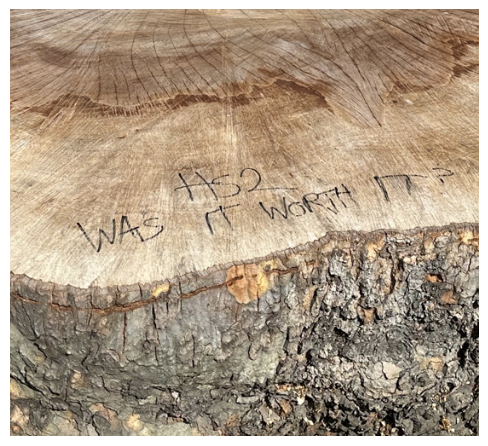
A neighbouring freshly-created stump at Euston, on which someone has scrawled the poignant question, “HS2 – was it worth it?”
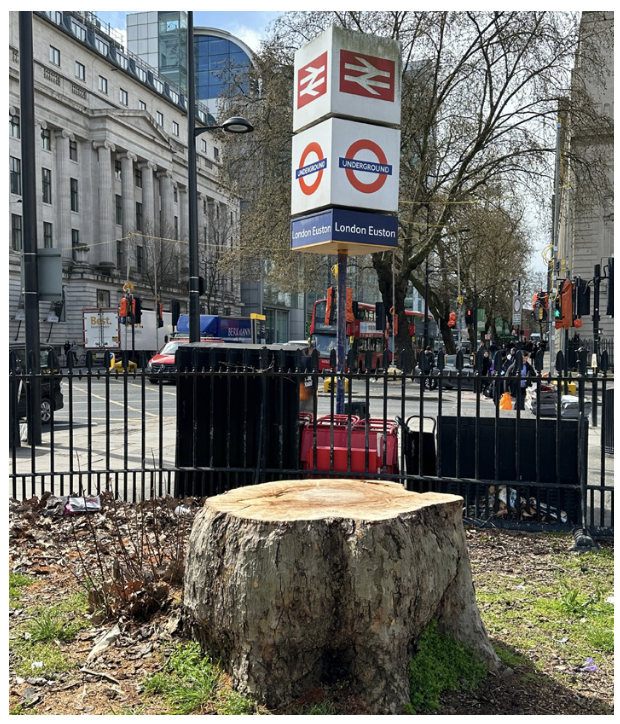
My version of the Euston photo that shocked and dismayed The Times’s Richard Morrison so greatly.
To Richard Morrison, the “devastating image seemed to epitomise the decline and fall of the United Kingdom as a sane, competent nation”. The tree(s) had been felled, he observed, because they stand in the way of the enlargement and rebuilding of Euston station “to cater for HS2 when (if) it arrives”. Acknowledging that some might consider the loss “regrettable but necessary” for such a scheme, Mr Morrison countered that idea with three rather significant reasons, or contexts.
The first is that our towns and cities had lost millions of trees in his lifetime. As he put it, “We chop down trees to widen roads, build shopping centres or on the slightest health-and-safety pretext – often at dead of night because the felling is frequently done despite anguished opposition from local people”.
The second is that all this was going on “despite everything we know about what keeps us, and our planet, alive and healthy”. He pointed out that, “Trees suck in bad fumes. That’s why plane trees were planted in London in the first place, centuries ago”, going on to add that, “Boy, does the Euston Road still need them”.
The third context is what Richard Morrison considers the most shaming. It’s that there was no urgent need for the Euston trees to come down now, or for years, and perhaps not ever. “Just days before they were felled, the transport secretary Mark Harper announced that the entire HS2 project was being rethought and work on the new Euston station was being paused”, he notes.
So, what may these three sorry sets of summary tree executions tell us?
Let me start on the moral of this tale by making it plain that I don’t think any tree should automatically be immune from the threat of removal, however much a beloved veteran it may be. Apart from anything else, felling some ailing trees might reasonably be considered an act of kindness to them. Some trees are just a windy day away from falling anyway. And, of course, there are other good reasons why the removal of particular trees, on occasions, might reasonably be justified. However, in all the instances I have referred to, the justification for felling on the scale undertaken, and the manner of it, seems to be – at the very least – subject to legitimate challenge and, therefore deserving of a thorough and transparent review.
But it’s not just the lack of transparency that characterises the Sheffield, Plymouth and Euston stories; it’s also the high-handed, even aggressive, response of those in power to the challenges they received. The precise character of the responses in these three cases varied, but all featured a notable tone-deafness. The following quote, attributed by BBC London News to an HS2 Spokesperson in connection with the latest Euston felling, is dispiritingly reminiscent of the reaction of the Sheffield and Plymouth Councillors, and those working for them, as reported by Sir Mark Lowcock and the Plymouth Herald: “All works at the Euston site are still necessary… to deliver new high-speed rail services into central London”. In other words, “We’re right; you’re wrong”, or, “Those trees were standing in the way of progress, and we shall define what that means on your behalf, thank you very much”.
Something else the HS2 spokesperson said, however, is worthy of consideration: “The HS2 programme will transform the Euston area and includes a huge scheme to create new wildlife habitat and plant seven million trees and shrubs”. This raises the important matter of what could be called ‘betterment’ or even ‘Biodiversity Net Gain’ in the language of the moment. This argument might be phrased as, “What does it really matter if a lovely, old and healthy tree is destroyed if it’s replaced many times over?”, or, “If the environmental and ecological ledger is in credit at the end, aren’t we in danger of over-sentimentalising the issue by being overly concerned with local specifics?”
As all of the examples I have cited surely prove, however, and as Lowcock spells out, the value many people place on their familiar local trees goes beyond eco-maths; and, as in so many other fields, raises the issue of how we assess subjective considerations alongside objective ones. This is plainly a whole topic of its own, so, for now, I’ll simply say that I have happily discovered that a new version has just been published of a rather marvellous document called CAVAT - Capital Asset Value for Amenity Trees.
The CAVAT methodology for measuring the public benefits of trees is an excellent starting point for any discussions, and decision-making processes, in this area. First introduced by Chris Neilan and those good people at the London Tree Officers Association (LTOA) in 2008, subsequently joined by the Municipal Tree Officers’ Association (MTOA), it’s regarded as one of the principal methods of tree valuation in the UK.
CAVAT provides a method for managing trees as public assets rather than liabilities. It’s designed to be not only a strategic tool and an aid to decision-making in relation to the tree stock as a whole, but also to be applicable to individual cases, where the value of a single tree needs to be expressed in monetary terms.
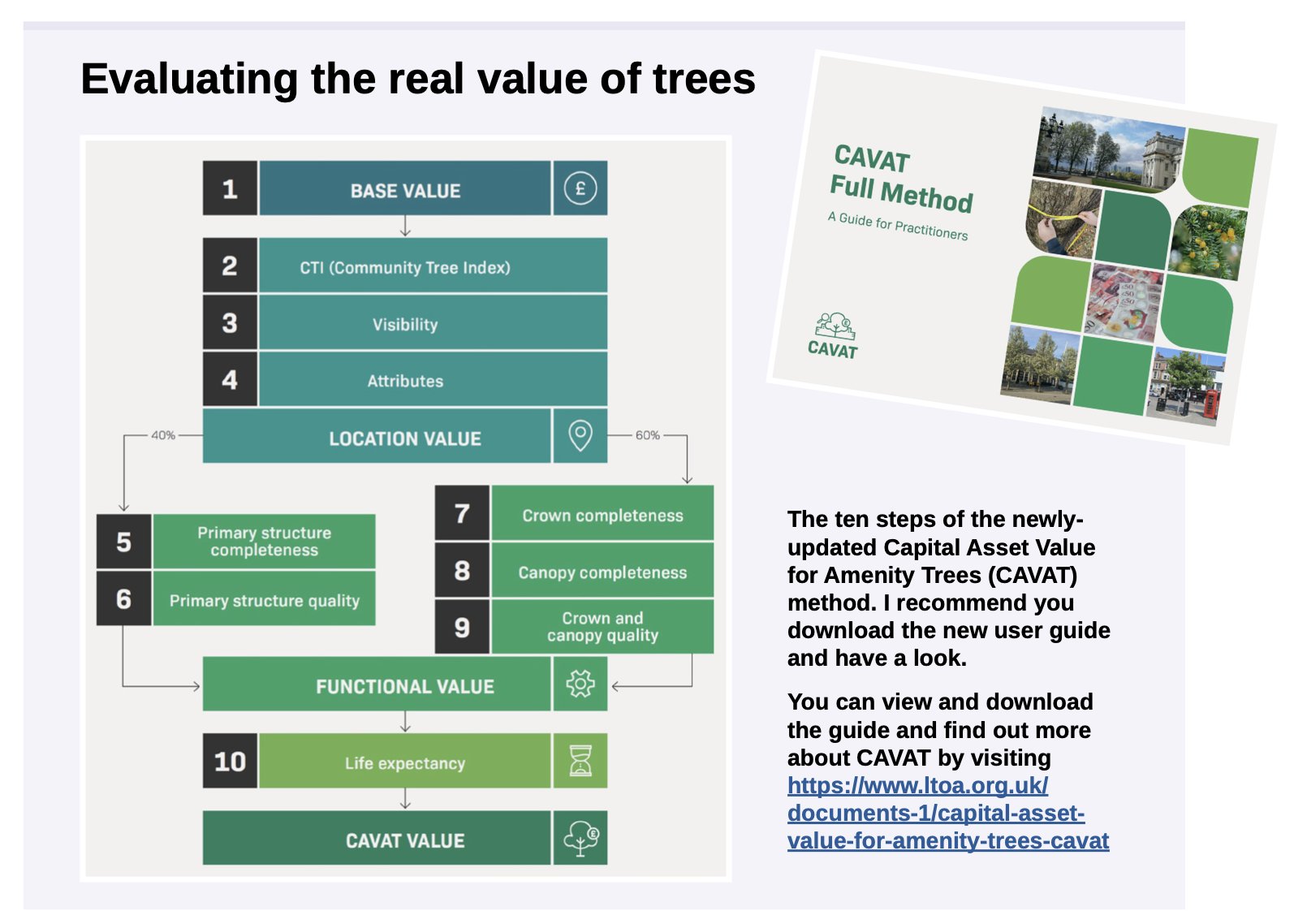
I’m glad to be able to tell you that an updated and freely available version was launched at the end of March, together with a brand new and fully illustrated Guide for Practitioners. You can download the guide and find out more about CAVAT by visiting this link. Personally, I think the use of CAVAT should be an absolute requirement for any project or programme where the potential loss and/or replacement of trees is being contemplated.
I’ll also say, just as simply, that one of the best ways of putting to the test people’s subjective views about trees – or indeed almost any other issue – is to conduct robust public engagement around real situations. If, when the people speak, they say something you don’t like, then it should – as an absolute minimum – cause you to reflect upon what they may be seeing and feeling that you have missed, and to work all the harder to make your case. It should definitely not prompt you to pursue exactly the same course as before, only this time with hubris, exaggerated self-belief, undue haste and menaces.
I wrote earlier about things being hidden in plain sight, and it may just possibly have occurred to you that the three examples I’ve given very much do not fall into that category – because the very reason they came to my attention is because people noticed and objected. My defence to this perfectly reasonable charge is that my featured case studies that made the news, are classic ‘exceptions that prove the rule’. Once your tree-loss senses have started functioning as mine have, and if you get out and about like I do, you’ll observe newly-made and officially-sanctioned stumps of trees far more frequently than you previously did. One of the photos I’ve included here (which happens to be from Sunderland) is a zoomed-in extract from a photo that shows at least four examples of recently-hewn, large trunks. I asked the excellent fellow who was showing me round why these trees had been felled, and he had no idea. There may have been a good reason, but none was obvious.
I also wrote earlier about authorities indulging in substantial tree felling despite seeming (for policy and/or other reasons) to be well-intentioned folk that would never do such a thing, other than in extremis.
Indeed, at around the same time as Sheffield was chopping down trees at an alarming rate, it was also developing and implementing its rightly lauded and celebrated ‘Grey to Green’ programme to “bring colour and sustainability to inner-city Sheffield”. This has included transforming a tarmacked area into a green public space that encourages cycling and walking. “Designed with climate change, wellbeing and economic investment in mind, Grey to Green is helping to lay foundations for a healthy, sustainable future for part of Sheffield” is the official citation for the project. Read more at https://www.greytogreen.org.uk/
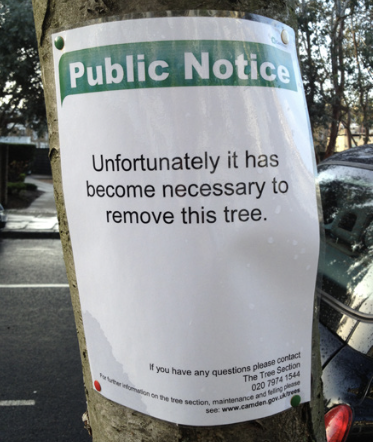
This notice, on an ordinary street tree, doesn’t give much information, but at least anticipates that local people might have concerns, and provides a contact for queries. Good work by Camden Council.
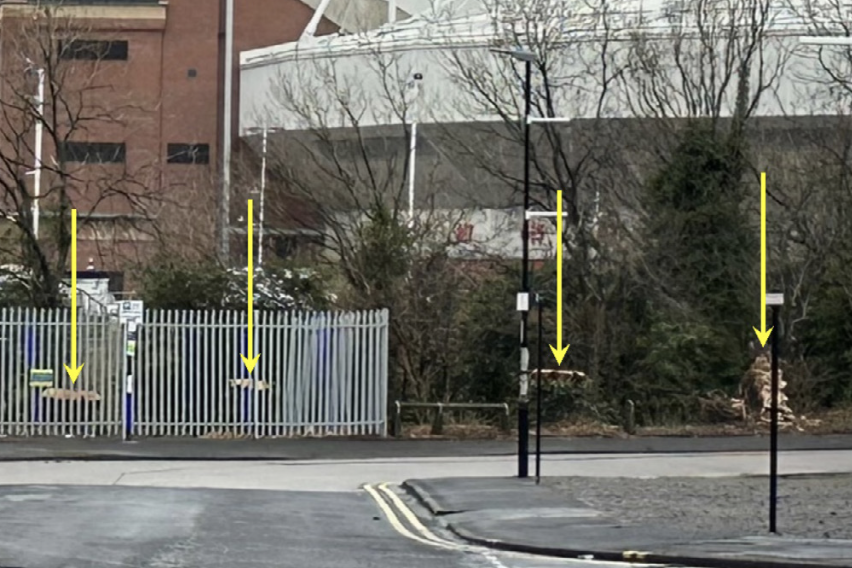
That photo I took in Sunderland recently – with (at least) four new, large tree stumps behind the fence in the middle distance, perhaps felled to reveal that lovely view. Once noticed, hard to unsee.
As for Plymouth, in March 2019, the Council unanimously declared a Climate Emergency. The city has a history of alternating between Labour and the Conservative control, with the margins often very fine. Labour ran the administration after the 2018 elections, while the Conservatives did so after May 2022. But all members of all parties voted to declare the climate emergency. I have written before about what such declarations seem to mean – or sometimes not mean – in practice (LTT793 in March 2020), and I am once again seeking to reflect upon how words match actions, or don’t. A Council that recognises the Climate Emergency, and has an active Climate Emergency Action Plan (which, incidentally, features tree planting programmes), should not – to my way of thinking – be one that rushes to chop down trees despite ‘meaningful engagement’ which found that the people of the city didn’t want it to do so.
In the same vein, in January 2022, the HS2 people wanting to rid Euston station of inconvenient trees published an Environmental Sustainability Vision. You will not, of course, find any commitments within it concerning tree loss (they knew what they had already done and were planning). But you will find promises to “secure biodiversity gains on Phase One and Phase 2a, moving beyond no net loss” and, more vaguely, a commitment to “seek to achieve a 10% net gain in biodiversity on Phase 2b western leg”. There are also statements about planting seven million trees and shrubs for the Green Corridor along Phase One, about £7m of funding to plant new woodlands and improve existing woodlands along Phase One and 2a, and about minimising the loss of ancient woodlands. These seem to me (a) quite fair, but also (b) inconsistent with the “We-know-what-we’re-doing-and-(trust-us)-there’s-no-alternative” approach adopted at Euston.
I cannot resist concluding with a return to the trusty reverse version of the ‘can’t see the wood for the trees’ analogy. The issue seems to be that, for some ‘in authority’, the ‘Big Picture’ over-rules the local, and the things that are important to the ordinary ‘People in the Street’. By so doing, those at the top of the tree (sorry!) wield powers in a way that no-one intended they should have. This isn’t about holding a referendum on the fate of each tree, but it is about a properly democratic process. Those now-lamented trees can be seen as avoidable collateral damage in that ongoing struggle.
John Dales is a streets design adviser to local authorities around the UK, a member of several design review panels, and one of the London Mayor’s Design Advocates. He’s a past chair of the Transport Planning Society, a former trustee of Living Streets, and a committee member of the Parliamentary Advisory Council for Transport Safety. He is director of transport planning and street design consultancy Urban Movement.
This article was first published in LTT magazine, LTT867, 24 April 2023.
You are currently viewing this page as TAPAS Taster user.
To read and make comments on this article you need to register for free as TAPAS Select user and log in.

Log in